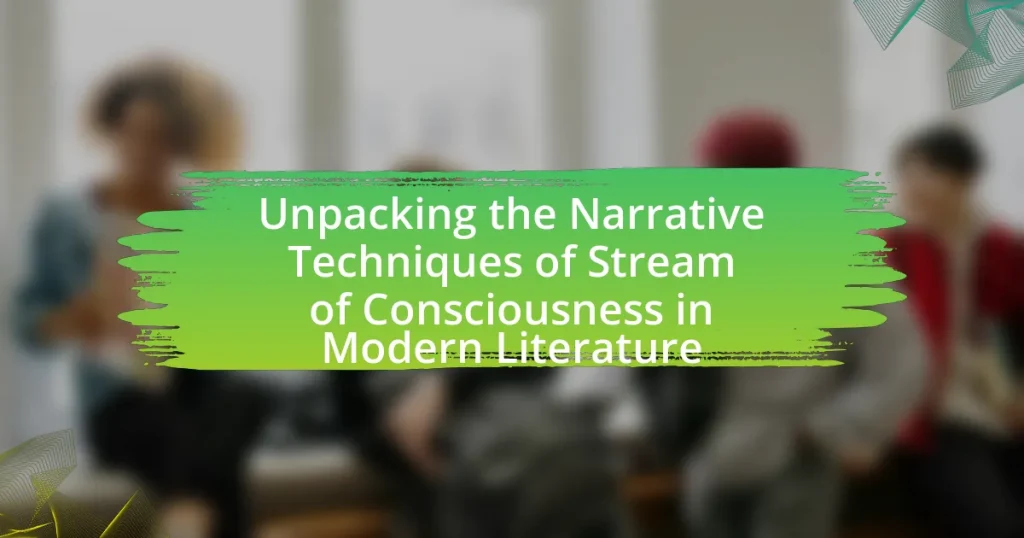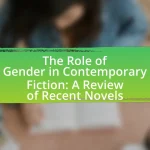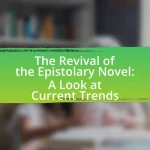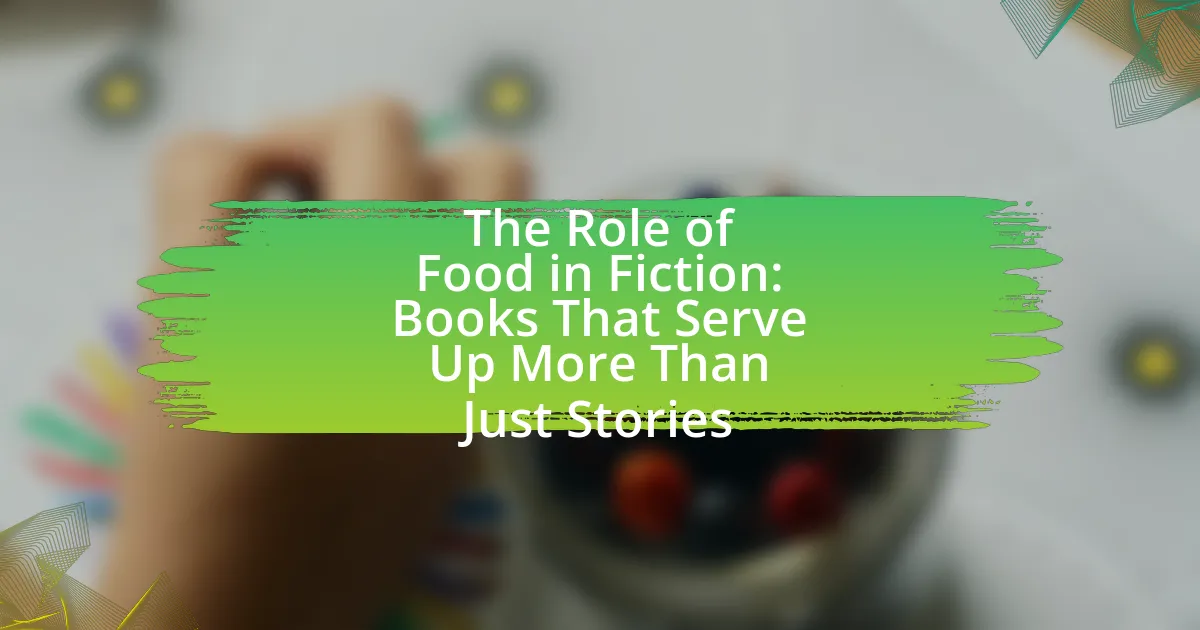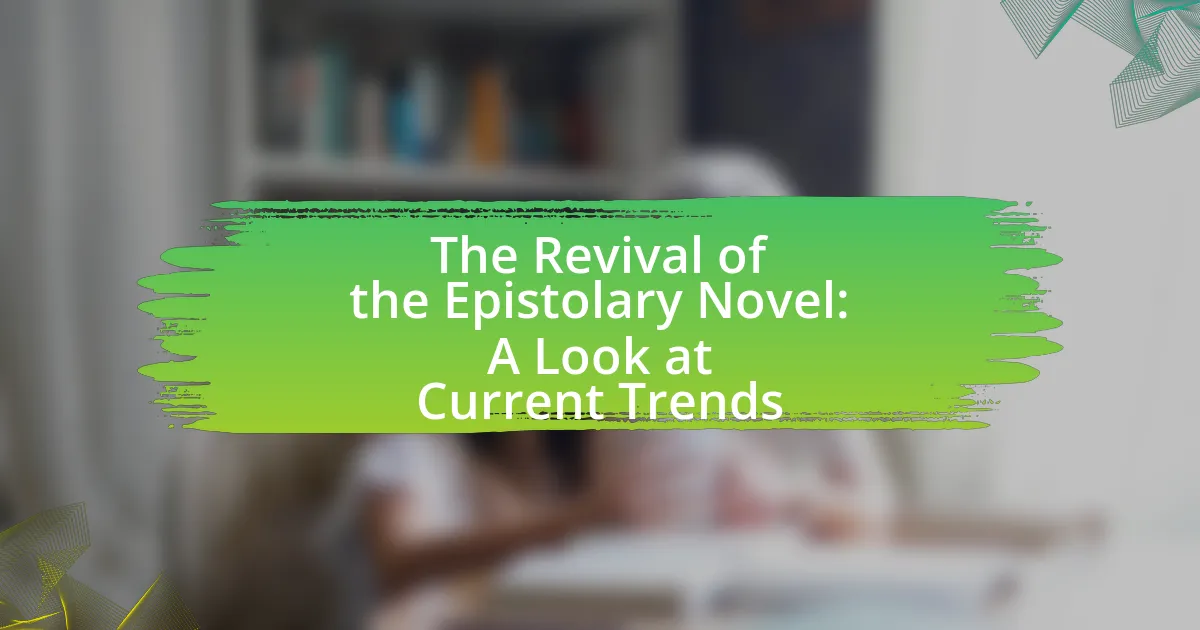The article focuses on the narrative techniques of stream of consciousness in modern literature, highlighting key methods such as interior monologue, free association, and non-linear narrative structure. It examines the emergence of this technique in the early 20th century, influenced by psychological theories and modernist literature, with notable authors like James Joyce and Virginia Woolf exemplifying its use. The article also discusses the defining characteristics of stream of consciousness, its impact on character development and reader engagement, and the challenges writers face when employing this technique. Additionally, it explores the themes commonly addressed through this narrative style, including identity, memory, and existentialism, providing practical tips for writers to effectively implement stream of consciousness in their work.

What are the Narrative Techniques of Stream of Consciousness in Modern Literature?
The narrative techniques of stream of consciousness in modern literature include interior monologue, free association, and non-linear narrative structure. Interior monologue allows characters’ thoughts to flow freely, reflecting their inner experiences without conventional dialogue. Free association connects thoughts and memories in a fluid manner, often disregarding logical progression, which mirrors the natural thought process. Non-linear narrative structure disrupts chronological storytelling, enabling authors to present events as they occur in the characters’ minds, creating a more immersive experience. Prominent examples of these techniques can be found in works by authors such as James Joyce in “Ulysses” and Virginia Woolf in “Mrs. Dalloway,” where the narrative closely follows the characters’ subjective experiences and perceptions.
How did Stream of Consciousness emerge as a narrative technique?
Stream of Consciousness emerged as a narrative technique in the early 20th century, primarily influenced by the psychological theories of Sigmund Freud and the modernist movement in literature. This technique seeks to capture the flow of thoughts and feelings in a character’s mind, often disregarding traditional narrative structures. Writers such as James Joyce, Virginia Woolf, and William Faulkner utilized this approach to explore the complexities of human consciousness, allowing readers to experience the inner workings of characters’ minds in a more intimate and immediate way. The technique reflects a shift towards subjective experience and the exploration of time and memory, marking a significant evolution in narrative form during this period.
What historical and literary contexts influenced its development?
The development of stream of consciousness as a narrative technique was influenced by the historical context of the early 20th century, particularly the psychological theories of Sigmund Freud, which emphasized the exploration of the unconscious mind. This period also saw the impact of modernism, characterized by a break from traditional narrative forms and a focus on subjective experience. Literary figures such as James Joyce and Virginia Woolf utilized this technique to reflect the complexities of human thought and perception, as seen in Joyce’s “Ulysses” and Woolf’s “Mrs. Dalloway.” These works exemplify how the stream of consciousness technique captures the fluidity of thought and the intricacies of character consciousness, aligning with the modernist movement’s goals of innovation and introspection.
Who are the key authors associated with this technique?
Key authors associated with the stream of consciousness technique include James Joyce, Virginia Woolf, and William Faulkner. James Joyce’s “Ulysses” exemplifies this technique through its interior monologues and nonlinear narrative structure. Virginia Woolf’s “Mrs. Dalloway” employs stream of consciousness to explore characters’ thoughts and perceptions in real-time. William Faulkner’s “The Sound and the Fury” utilizes this technique to present multiple perspectives and fragmented timelines, showcasing the complexity of human consciousness. These authors are pivotal in defining and popularizing the stream of consciousness narrative style in modern literature.
What are the defining characteristics of Stream of Consciousness?
Stream of Consciousness is characterized by a narrative technique that captures the flow of thoughts and feelings in a character’s mind. This technique often employs a non-linear structure, allowing for a fragmented and associative style that mirrors human thought processes. Additionally, it frequently utilizes interior monologue, where characters express their thoughts directly, often without conventional punctuation or grammar, creating a sense of immediacy and intimacy. Prominent examples include James Joyce’s “Ulysses” and Virginia Woolf’s “Mrs. Dalloway,” which illustrate these characteristics through their innovative narrative forms.
How does it differ from traditional narrative styles?
Stream of consciousness differs from traditional narrative styles by prioritizing the inner thoughts and feelings of characters over structured plot development. Traditional narratives typically follow a linear progression with clear exposition, rising action, climax, and resolution, while stream of consciousness often presents a fragmented and non-linear flow of thoughts, mimicking the natural thought process. This technique allows for a deeper psychological exploration of characters, as seen in works like James Joyce’s “Ulysses,” where the narrative captures the characters’ immediate thoughts and sensory experiences, creating a more intimate and immersive reading experience.
What role does interior monologue play in this technique?
Interior monologue serves as a crucial mechanism in the stream of consciousness technique, allowing authors to convey a character’s thoughts and emotions in a direct and unfiltered manner. This narrative device immerses readers in the character’s psyche, presenting their internal dialogue and reflections in real-time, which enhances the authenticity of their experiences. For instance, in Virginia Woolf’s “Mrs. Dalloway,” the use of interior monologue reveals the protagonist’s fragmented thoughts, illustrating her mental state and the passage of time, thereby deepening the reader’s understanding of her character. This technique effectively blurs the line between thought and narrative, creating a more intimate connection between the reader and the character’s inner world.
Why is Stream of Consciousness significant in modern literature?
Stream of Consciousness is significant in modern literature because it captures the inner thoughts and feelings of characters in a way that reflects the complexity of human consciousness. This narrative technique allows authors to present a more authentic and immersive experience, as seen in works by Virginia Woolf and James Joyce, who utilized this style to explore the intricacies of their characters’ minds. The significance is further underscored by its ability to break traditional narrative structures, enabling a fluid and nonlinear exploration of time and memory, which aligns with the psychological theories of the early 20th century, such as those proposed by Sigmund Freud.
How does it reflect the complexities of human thought?
Stream of consciousness reflects the complexities of human thought by capturing the fluid and often chaotic nature of internal monologue. This narrative technique allows authors to present thoughts as they occur, mirroring the non-linear and fragmented way in which humans process experiences and emotions. For instance, Virginia Woolf’s “Mrs. Dalloway” illustrates this through characters’ shifting thoughts and memories, revealing how past experiences influence present perceptions. Such representation aligns with psychological theories, like those of William James, who emphasized the continuous flow of consciousness, thereby validating the technique’s effectiveness in portraying the intricacies of human cognition.
What impact has it had on contemporary storytelling?
Stream of consciousness has significantly influenced contemporary storytelling by allowing authors to explore characters’ inner thoughts and emotions in a fluid, non-linear manner. This narrative technique enables a deeper psychological insight into characters, as seen in works by Virginia Woolf and James Joyce, who pioneered this style. Their use of stream of consciousness has led to a shift in narrative structure, encouraging modern writers to experiment with time, perspective, and voice, ultimately enriching the complexity and depth of contemporary literature.
How does Stream of Consciousness affect reader engagement?
Stream of Consciousness enhances reader engagement by immersing readers in the characters’ thoughts and emotions, creating a more intimate connection. This narrative technique allows readers to experience the flow of consciousness in real-time, which can evoke empathy and a deeper understanding of the characters’ internal struggles. Research indicates that this style can lead to increased emotional investment; for example, studies show that readers often feel more connected to characters presented through Stream of Consciousness due to the immediacy and authenticity of their experiences.
What challenges do writers face when using this technique?
Writers face several challenges when using the stream of consciousness technique, primarily related to coherence and reader engagement. This narrative style often results in fragmented thoughts and non-linear timelines, which can confuse readers and make it difficult for them to follow the plot. Additionally, maintaining character voice and authenticity becomes challenging, as writers must balance the inner monologue with external actions and dialogue. Research indicates that while stream of consciousness can create deep psychological insight, it risks alienating readers who prefer more structured narratives, as seen in works by authors like Virginia Woolf and James Joyce, who both faced criticism for their complex narrative styles.
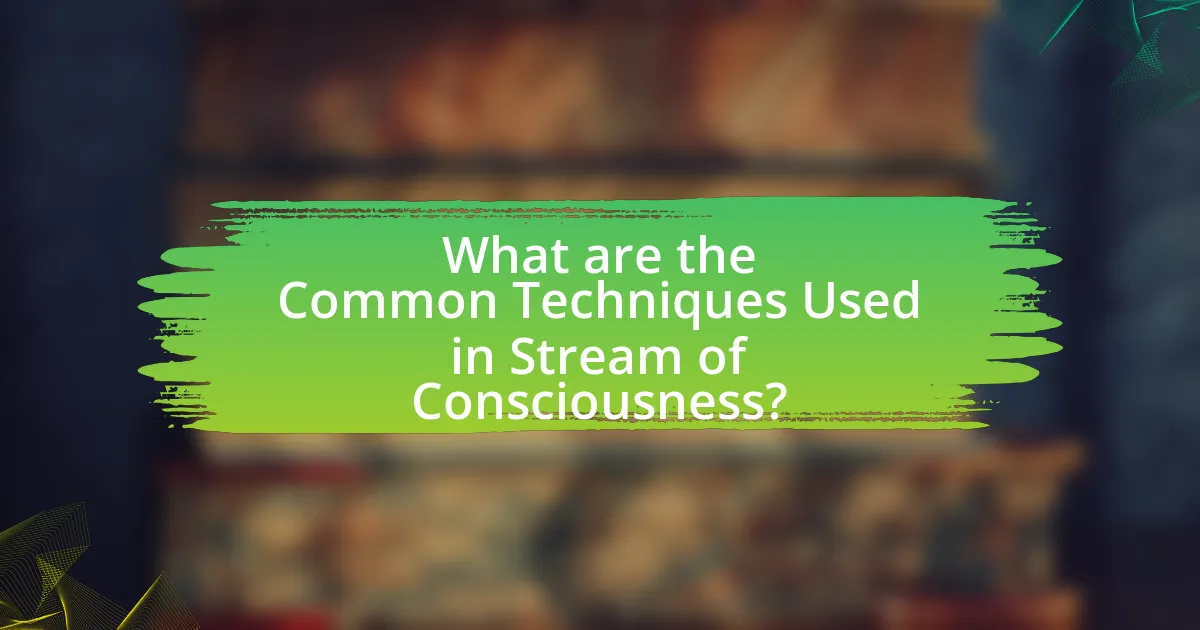
What are the Common Techniques Used in Stream of Consciousness?
Common techniques used in stream of consciousness include interior monologue, free association, and non-linear narrative. Interior monologue allows characters’ thoughts to flow freely, revealing their inner experiences without structured dialogue. Free association connects thoughts in a seemingly random manner, reflecting the natural thought process. Non-linear narrative disrupts chronological order, presenting events as they occur in the character’s mind, which can create a more immersive experience. These techniques are exemplified in works by authors like Virginia Woolf and James Joyce, who effectively capture the complexity of human thought.
How do authors implement free association in their narratives?
Authors implement free association in their narratives by allowing characters’ thoughts to flow without logical sequence, reflecting their inner experiences and emotions. This technique often manifests through fragmented sentences, abrupt shifts in topic, and a lack of conventional punctuation, which mirrors the natural thought process. For example, Virginia Woolf in “Mrs. Dalloway” employs free association to illustrate the protagonist’s stream of consciousness, revealing her memories and feelings in a non-linear fashion. This method enhances the reader’s understanding of characters’ psychological states and creates a more immersive narrative experience.
What examples illustrate the use of free association effectively?
Effective examples of free association can be found in the works of Virginia Woolf and James Joyce. In Woolf’s “Mrs. Dalloway,” the narrative flows seamlessly between characters’ thoughts and memories, illustrating how free association reveals their inner lives and connections to time and place. Similarly, Joyce’s “Ulysses” employs free association through its stream-of-consciousness technique, allowing readers to experience the characters’ thoughts in real-time, reflecting their emotions and perceptions. These examples demonstrate how free association serves as a powerful tool in modern literature to convey complex psychological states and enhance narrative depth.
How does free association enhance character development?
Free association enhances character development by allowing characters to express their thoughts and emotions in an unfiltered manner, revealing their inner conflicts and motivations. This technique provides insight into a character’s psyche, as it captures the spontaneous flow of ideas and feelings, which can lead to a deeper understanding of their personality and experiences. For example, in Virginia Woolf’s “Mrs. Dalloway,” the use of free association illustrates Clarissa Dalloway’s complex emotional landscape, showcasing her memories and desires, which ultimately enriches her character portrayal. This method not only deepens reader engagement but also facilitates a more nuanced exploration of identity and consciousness in modern literature.
What is the role of fragmented narrative in Stream of Consciousness?
The role of fragmented narrative in Stream of Consciousness is to reflect the chaotic and nonlinear nature of human thought processes. This technique allows authors to convey the complexities of consciousness by presenting thoughts, memories, and sensory experiences in a disjointed manner, mirroring how individuals actually think. For example, in Virginia Woolf’s “To the Lighthouse,” the fragmented narrative structure captures the characters’ inner lives and fluctuating emotions, emphasizing the fluidity of time and perception. This approach enhances the reader’s immersion into the characters’ minds, illustrating the intricacies of their psychological states and experiences.
How does fragmentation affect the flow of the story?
Fragmentation disrupts the linear progression of a story, creating a non-traditional narrative structure that reflects the complexities of human thought and experience. This technique allows authors to present multiple perspectives, emotions, and temporal shifts simultaneously, which can enhance the depth of character development and thematic exploration. For instance, in Virginia Woolf’s “To the Lighthouse,” the fragmented narrative mirrors the characters’ inner lives, illustrating their thoughts and feelings in a way that traditional storytelling may not capture. This approach can lead to a more immersive reading experience, as it challenges readers to piece together the narrative, thereby engaging them more actively in the story.
What techniques do authors use to maintain coherence despite fragmentation?
Authors maintain coherence despite fragmentation through techniques such as thematic unity, character consistency, and the use of narrative devices like repetition and imagery. Thematic unity ensures that even fragmented thoughts relate back to central ideas, providing a cohesive framework. Character consistency allows readers to follow a character’s internal logic and emotional journey, creating a sense of continuity. Additionally, narrative devices like repetition reinforce key concepts and imagery evoke shared experiences, linking disparate thoughts and enhancing overall coherence. These techniques are evident in works like Virginia Woolf’s “Mrs. Dalloway,” where the stream of consciousness method effectively connects fragmented perceptions through recurring themes and character reflections.
How do sensory details contribute to the Stream of Consciousness technique?
Sensory details enhance the Stream of Consciousness technique by immersing readers in the character’s internal experiences. This technique captures the flow of thoughts and feelings as they occur, often resembling the natural thought process. Sensory details, such as sights, sounds, and smells, provide vivid imagery that reflects the character’s emotional state and immediate environment, making the narrative more relatable and engaging. For example, in Virginia Woolf’s “Mrs. Dalloway,” the use of sensory descriptions allows readers to experience Clarissa Dalloway’s memories and perceptions in real-time, illustrating how her thoughts are influenced by her surroundings. This integration of sensory information deepens the reader’s understanding of the character’s psyche and enhances the overall narrative experience.
What types of sensory details are most commonly used?
The most commonly used types of sensory details in literature include visual, auditory, tactile, olfactory, and gustatory details. Visual details describe what can be seen, such as colors, shapes, and movements, while auditory details pertain to sounds, including voices, music, and environmental noises. Tactile details evoke the sense of touch, describing textures and temperatures. Olfactory details relate to smells, and gustatory details involve tastes. These sensory details enhance the reader’s experience by creating vivid imagery and emotional resonance, as evidenced by their frequent use in modern literature to convey characters’ inner thoughts and feelings.
How do sensory details enhance the reader’s experience?
Sensory details enhance the reader’s experience by creating vivid imagery that immerses them in the narrative. When authors incorporate sensory elements such as sight, sound, taste, touch, and smell, they evoke emotional responses and foster a deeper connection to the characters and settings. For example, in Virginia Woolf’s “To the Lighthouse,” the detailed descriptions of the sea’s sound and the scent of the flowers allow readers to experience the environment alongside the characters, making the narrative more engaging. This technique not only enriches the storytelling but also aids in conveying themes and emotions effectively, as supported by research in cognitive psychology that shows sensory details can improve memory retention and emotional engagement in readers.
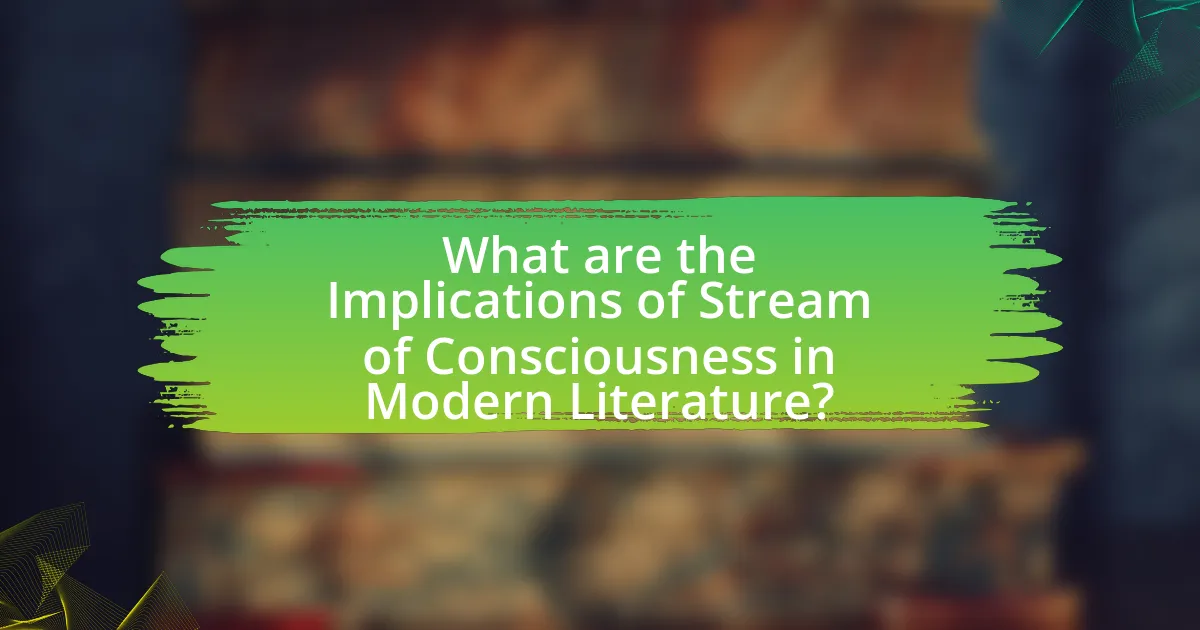
What are the Implications of Stream of Consciousness in Modern Literature?
The implications of stream of consciousness in modern literature include a profound shift in narrative technique that emphasizes the inner thoughts and feelings of characters, allowing for a more intimate exploration of consciousness. This technique, utilized by authors such as Virginia Woolf and James Joyce, breaks traditional narrative structures and reflects the complexities of human thought processes. The use of fragmented and nonlinear storytelling mirrors the chaotic nature of real-life experiences, thereby enhancing the reader’s engagement with the characters’ psychological states. Additionally, stream of consciousness challenges readers to interpret meaning from the flow of thoughts rather than relying on a straightforward plot, fostering a deeper understanding of character motivations and emotional landscapes.
How does Stream of Consciousness challenge conventional narrative structures?
Stream of Consciousness challenges conventional narrative structures by prioritizing the inner thoughts and feelings of characters over a linear plot. This technique often eschews traditional grammar and punctuation, creating a flow of thoughts that mimics natural human cognition. For example, in James Joyce’s “Ulysses,” the narrative shifts seamlessly between different characters’ perspectives and timeframes, reflecting the complexity of human consciousness. This approach disrupts the expected chronological storytelling and instead presents a fragmented, non-linear experience that emphasizes subjective reality.
What are the effects of this challenge on plot development?
The challenge of stream of consciousness narrative techniques significantly affects plot development by prioritizing character thoughts and emotions over traditional linear storytelling. This approach often leads to fragmented narratives, where the plot unfolds through the internal experiences of characters rather than through external actions or events. For instance, in Virginia Woolf’s “Mrs. Dalloway,” the plot is shaped by the characters’ reflections and memories, creating a rich tapestry of interconnected thoughts that drive the narrative forward. This technique can enhance emotional depth and complexity, allowing readers to engage with the characters on a more intimate level, thereby transforming the conventional understanding of plot progression.
How does it influence character perception and depth?
Stream of consciousness influences character perception and depth by providing direct access to a character’s thoughts and feelings, allowing readers to experience their internal struggles and motivations intimately. This narrative technique reveals the complexities of a character’s psyche, often blurring the lines between reality and perception, which enhances emotional engagement. For example, in Virginia Woolf’s “Mrs. Dalloway,” the use of stream of consciousness allows readers to understand Clarissa Dalloway’s reflections on her past and present, deepening the reader’s insight into her character and emotional state. This technique effectively creates a multi-dimensional portrayal of characters, making them more relatable and nuanced.
What themes are commonly explored through Stream of Consciousness?
Stream of Consciousness commonly explores themes of inner thoughts, identity, time, and perception. This narrative technique allows authors to delve deeply into characters’ mental processes, revealing their subconscious thoughts and emotions. For instance, in Virginia Woolf’s “Mrs. Dalloway,” the fluidity of time and the complexity of identity are examined through the characters’ reflections and memories, illustrating how past experiences shape present consciousness. Similarly, James Joyce’s “Ulysses” employs this technique to explore the intricacies of human perception and the mundane aspects of daily life, emphasizing the richness of ordinary experiences. These examples demonstrate how Stream of Consciousness effectively captures the multifaceted nature of human experience.
How do existential themes manifest in this narrative style?
Existential themes manifest in the stream of consciousness narrative style through the exploration of individual consciousness and the subjective experience of reality. This technique allows authors to delve deeply into characters’ thoughts, revealing their internal struggles, uncertainties, and the search for meaning in an indifferent universe. For instance, in Virginia Woolf’s “Mrs. Dalloway,” the fragmented thoughts of Clarissa Dalloway illustrate her existential reflections on life, death, and identity, showcasing how her perceptions shape her reality. This narrative style effectively conveys the complexity of human existence, emphasizing the characters’ isolation and the absurdity of their circumstances, which are central to existential philosophy.
What role does memory play in the exploration of themes?
Memory serves as a crucial mechanism in the exploration of themes within modern literature, particularly through the stream of consciousness technique. This narrative style allows characters to reflect on their past experiences, emotions, and thoughts, thereby revealing deeper thematic elements such as identity, time, and existentialism. For instance, in Virginia Woolf’s “To the Lighthouse,” the characters’ memories shape their perceptions and interactions, illustrating how the past influences the present and highlights themes of loss and the passage of time. This interplay between memory and theme enriches the narrative, providing readers with insights into the characters’ inner lives and the broader human experience.
What practical tips can writers use to effectively employ Stream of Consciousness?
Writers can effectively employ Stream of Consciousness by focusing on the inner thoughts and feelings of characters without interruption. This technique requires writers to use free association, allowing thoughts to flow naturally, which can be achieved through minimal punctuation and unconventional sentence structures. Additionally, incorporating sensory details and fragmented thoughts can enhance the authenticity of the character’s mental state. For instance, Virginia Woolf’s “Mrs. Dalloway” exemplifies this by seamlessly blending the character’s perceptions with the narrative, illustrating how thoughts can shift rapidly in real life. This method not only captures the complexity of human consciousness but also engages readers by immersing them in the character’s experience.
